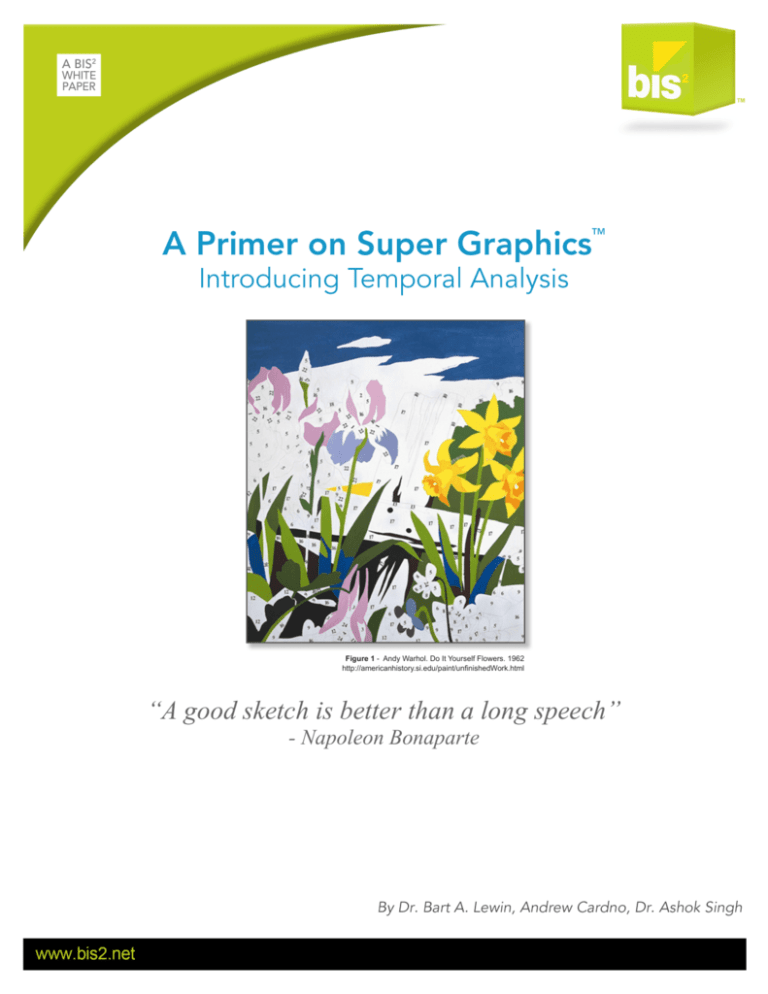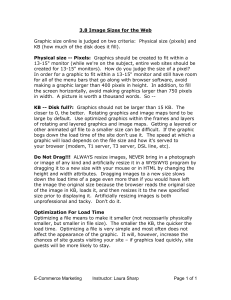
Figure 1 - Andy Warhol. Do It Yourself Flowers. 1962
http://americanhistory.si.edu/paint/unfinishedWork.html
“A good sketch is better than a long speech”
- Napoleon Bonaparte
2
A Primer on Super Graphics Introducing Temporal Analysis
CONTENTS
TM
PAGE
Paint and Calculate By Numbers 2
Observations on Minard's Visualization
3
Example: Temporal Super Graphic
4
Temporal Super Graphic Observations 4
Conclusion 5
Andy Warhol, Do it Yourself Flowers, 1962.
http://artobserved.com/artimages/2010/11/andy-warhol-do-it-yourself-flowers-1962.jpg
PAINT AND CALCULATE BY NUMBERS
In the 1950s, the Palmer Paint Company marketed the first
paint-by-numbers products.¹ “Master” artists provided specific
outlines and the colors that allowed the amateur to create
paintings well beyond his or her capability. Another way to
look at it is that they provided those with little artistic talent
the assistance needed to create appreciable artworks.
Though widely criticized by purists, these products were
soon very popular.
PAINT-BY-NUMBERS
It was not long before the paint-by-numbers phenomenon
became a metaphor to describe the modern world’s attempt
to mechanize everything - including art (Figure 1, front page).
and make visual data mining possible. However, just as the
paint-by-numbers master artists helped the amateur create
a pleasurable product, those creating and using data
visualization also require assistance from masters.
SKILLS REQUIRED
According to Stephen Few, “though simple, the skills that
are required by the many to make sense of data don’t come
naturally and the tools that support this effort are in short
supply. These skills must be taught, and well-designed tools
must be provided, to support cognitively rich immersion in
information.”
What the “purists” failed to appreciate, however, was the
pleasure that paint-by-numbers enthusiasts experienced
through approximating the output of the masters. Along with
delight, the paint-by-number artists gained knowledge and
an appreciation for the original art and artist.
He goes on to say, “we certainly don’t want all infovis
[information visualization] researchers to go through exactly
the same training resulting in a community of clones, but
there are a few fundamentals, other than those typically
found in computer science programs, which everyone should
learn. Here are a few often overlooked areas:
CHARLES MINARD
Training in psychology, especially visual perception
Charles Minard’s often-cited graphic of Napoleon’s 1812
March to Moscow (Figure 2, next page) uses colors, positions,
sizes, proportions, texts, and graphs to display related facts;
in a single canvas, it depicts what we would presently call
a 360o view of the event. The effects of the march, as well
as the causes, are quickly discerned when art is applied to
science in this manner. Edward Tufte, a recognized authority
on visual design, characterizes this work as “the best statistical
graph ever drawn”.² Given the richness of this depiction, it
goes well beyond the charts we commonly see in print, and
that are available to us in spreadsheet programs. Charts and
graphs are effective in presenting comparative data in two
or three dimensions. Minard artistically summarized multiple
dimensions of related data on a single page. This technique
allows a reader to, at a glance, understand the many causes
and effects related to the march.
Using graphics to depict related data in close proximity
allows the brain to more easily uncover patterns. These
data visualizations provide an alternative to statistical models
as it applies to data presentation
Training in data analysis, including actual experience
Training in design, especially visual and human-
computer interaction design
Training in the scientific method, including how to design, conduct, and publish robust research studies.
Those of us who guide research efforts are responsible both
for knowing these fundamentals ourselves, and instilling them
in our students.”
Few’s bulleted list of the skills required of infovis researchers
reveals a need for not just right brain technical and /or
statistical skills, but also left brain subjective skills - namely
training in psychology, visual perception, and humancomputer interaction design. Looking back at Minard’s
visualization (Figure 2), one can imagine the hours of
data analysis and summarization, and the scores of rough
drawings, required to achieve the end result.
1. http://americanhistory.si.edu/paint/rembrandt.html
2. Tufte, Edward; The Visual Display of Quantitative Information, Graphic Press, 2001, Second Edition, p.40.
A BIS2 White Paper
A Primer on Super Graphics Introducing Temporal Analysis
TM
3
Figure 2 — Charles Minard’s Visualization of Napoleon’s 1812 March to Moscow
OBSERVATIONS ON MINARDS VISUALIZATION
Top 10 Criteria for a Super Graphic™
The following section covers the 10 aspects of a Super Graphic
and how Super Graphics can be applied to the Minard
visualization (Figure 2):
1. Deterministic Framework: The display naturally lends itself to
the display of data. The framework is a spatial-temporal design
where the majority of the ink displayed is the shape of the
troop movement. This framework is the central theme, and the
relationship of the influencing factors are easily discerned by
virtue of their position.
2. Attributes (Dimensions and Measures) Are Self Comparable:
The content of the data defines the characteristics of the display.
There are 6 dimensions of data displayed, namely time, troop
size, temperature, latitude, longitude and distance. These
dimensions have been merged to show a complete picture.
3. Volume of Ink Related to Scale of Data: The overwhelming
majority of the ink used displays data in the spatial structure,
and shows the continuous decline in the number of troops over
the distance and time travelled.
4. Language Neutral: Even though the text is in French, the use
of graphics and numbers in the visualization allows non-French
readers to readily understand it.
5. Purpose is to Present Findings: The key way to understand
this feature is to attempt to read the graphic from any direction.
No matter which direction one reads the graphic, the story is
shown. Edward Tufte, in his seminars, describes a process
where one should allow observers to wander throughout
Super Graphics and develop their own story.
6. No Independent Legend: The Minard graphic has no
separate legend. This is the most difficult task in achieving
the status of Super Graphic. All of the elements that one
would include on a legend are clear on the graphic itself.
The number of troops are displayed at appropriate points in
the text, and the meaning of the color of the lines is apparent
by the spatial separation.
7. The Color is Metric and Excites the Key Points: The
use of color is the second most difficult area when creating
Super Graphics. The visual cortex is highly tuned to color
processing. Approximately 90% of the fovea input are color
receptors. The Minard graphic makes effective use of the
color of the troop movement into and out of Russia.
8. Pre-attentive Multi-layers of Information Shown: The
Minard graphic is a classic multi-layered map with annotation
overlaid over graphics. These layers are used to show
different dimensions of data.
9. Fine-Grained Measurability: The width of the line is an enlarged spatial representation - the distortion gives a directly
measurable (and continuous) value. Location and distance are also approximately measurable. Classification is not required for measurement.
10. Illustrates Causality: Although some historians argue that it was Russian forces, and not the cold that caused
deaths on the retreat, the clear linkage between
temperature (distance travelled) and deaths is
illustrated graphically.
A BIS2 White Paper
4
A Primer on Super Graphics Introducing Temporal Analysis
TM
EXAMPLE: TEMPORAL SUPER GRAPHIC
TEMPORAL SUPER GRAPHIC OBSERVATIONS
The following is a data visualization produced by BIS²’s
vizExplorer product (Figure 3). Depicted is a calendar
comparing the percentage of DVD rental revenue in the
family category over a seven-year period.
Understand seasonality by following the natural
The hot colors (reds) indicate periods of high percentages,
the intermediate colors (greens) represent periods of
average percentages,and the cool colors (blues) are periods
of low percentages. The intensity of the colors indicates the
relative values. The small dots are the beginnings of weeks
starting with 2001, spiraling out clockwise from the center.
The large red dots are the significant movie releases. The
size of the dot indicates the significance of the event.
Movie release analysis, over an extended period.
cyclical patterns.
Read from one week inside to out (or vice versa) to
If one starts at the center of the circle and follows a line of
the small dots indicating weeks toward the outer circle, one
can quickly compare the levels of sales over time in the
context of major film releases (the red dots are sized
relative to the significance of the event).
see year on year trends.
STRATEGIC
The family category represents a large percentage
of the overall business in April.
The family category contributes a fairly consistent
percentage of the overall revenue for the majority
of the year.
TACTICAL
There were uncharacteristic increases in revenue
during the 4th week of September 2004, and
Valentine’s Day 2005.
Figure 3 – Temporal Super Graphic
A BIS2 White Paper
A Primer on Super Graphics Introducing Temporal Analysis
TM
Top 10 Criteria for a Super Graphic™
5
5. Purpose is to Present Findings: Observers can read the
visualization from the inside or the outside (from past to present
or present to past). Broad patterns are shown along with microtrends. There is no guiding principal on where to start in the
interpretation.
The following section applies the Top 10 aspects of a
Super Graphic to BIS²’s Temporal Super Graphic (Figure
3, previous page):
1. Deterministic Framework: The display naturally
lends itself to the display of data. The spiral calendar
represents the natural cyclical structure of time.
6. No Independent Legend: This visualization could benefit
from a legend but it is not required for the majority of the
interpretation (e.g., colors known to be “hot” indicate areas
of high sales).
2. Attributes (Dimensions and Measures) Are Self
Comparable: The content of the data defines the
characteristics of the display. The combination of large
monthly and weekly cycles, with percentage of revenue
overlaid with key events, (meaning top 10 movie
releases) brings together 3-4 dimensions of data.
7. The Color is Metric and Excites the Key Points: The
extensive use of spectrum-based color scales enables a
metric reading of continuous values and intuitive interaction.
3. Volume of Ink Related to Scale of Data: The volume
of data shown in the heat map is comprised of 365 data
points of sales data. The volume and color of the ink
makes the scale used to represent sales volume evident.
4. Language Neutral: The movie titles are English
annotations (it could be argued that movie titles have
multilingual characteristics due to their global popularity),
but no aspects of the graphic require language specific
knowledge.
8. Pre-attentive Multi-layers of Information Show: Along
with annotation layers, the graphic has at least three layers
including heat, week and major releases.
9. Fine-Grained Measurability: The heat map provides a
specific color band. The size-graduated symbols (e.g., the
red dots) are a direct representation of the metric.
10. Illustrates Causality: The link between releases and
sales is apparent. The strong seasonality (e.g., April) is
also apparent.
CONCLUSION
In his classic work, F. J. Anscombe states that “graphs are essential to good statistical analysis.” He goes on to state that,
“graphs can have various purposes, such as: (i) to help us perceive and appreciate some broad features of the data, (ii)
to let us look behind those broad features and see what else is there.”³
As with the Minard visualization (Figure 2, see page 3), colors, positions, sizes, proportions, and texts are all used to
provide and communicate related information. The same multi-layered methods occur with the vizExplorer visualization
(Figure 3, previous page) as with Minard’s—the brain discerns patterns, thereby mining the data without reliance on black
box or other probabilistic statistical models. It illustrates the sales information and allows a human to make actionable
decisions based on the data—visual data mining.
Like the paint-by-numbers master artists, vizExplorer was designed and developed by masters. Its goal is to provide one,
without particular talent in visual design or statistics, with the ability to create complex and informative views of their data—
views capable of providing rapid understanding of the relationships in the data. Thus, producing the ability to act on the
new knowledge.
It accomplishes this goal by providing, in the form of software, expert guidance regarding how best to summarize and
display available raw data. The software turns the data into real information—guidance that everyone can use to create
far-reaching output; an accessible resource for learning.
3. Anscombe, F. J.; “Graphs in Statistical Analysis;” The American Statistician, Vol. 27, No. 1 (Feb., 1973), pp. 17-21. Emphasis added.
A BIS2 White Paper
This document contains proprietary information and may not be used,
reproduced or disclosed without explicit written permission from BIS2.
This document may also describe current and proposed product
features intended to be released depending on development and market
demands. Accordingly, the end product may not contain all product
features shown in this document.
vizExplorer, vizMaker and other BIS2 company, product or service
names are trademarks of BIS2. Other brand and product names are
trademarks of their respective companies. BIS2 comprises WME BI, LLC
and its subsidiaries.
Private & Confidential. Copyright © 2008 - 2013
NEW BIS SAFE LUXCO S.Á.R.L All Rights Reserved.
For more information, please contact us:
Web: Email: Phone: www.bis2.net
sales@bis2.net
Americas:
+1 800 323 5690 (U.S. Toll Free)
Americas:
+1 858 381 5092 (International)
Asia Pacific: +64 (0) 4 889 0228
NOV 2013- V3.3








